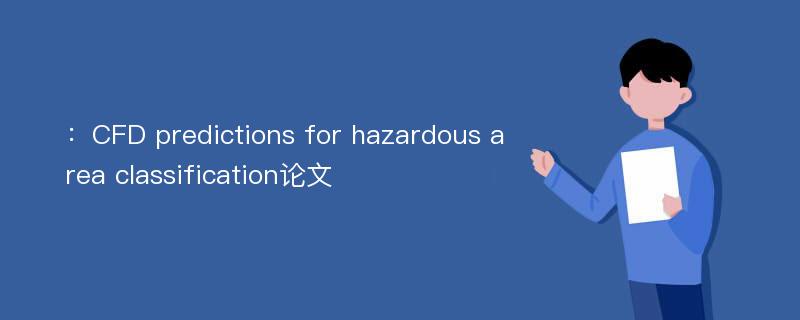
本文主要研究内容
作者(2019)在《CFD predictions for hazardous area classification》一文中研究指出:This study aimed to describe a Computational Fluid Dynamics(CFD) procedure using the ANSYS CFX software 16.1 and Design of Experiments for the determination of volume and extension of explosive atmospheres due to fugitive emissions of flammable gases.The multidimensional statistical sampling technique Latin Hypercube was used, which defined 100 simulations of random methane gas leak conditions.The CFD model proved to be robust in predicting the extension and volume of the explosive atmosphere for orifice diameters from 0.1 to2.5 mm, pressure from 0.1 MPa to 12 MPa and temperatures from 0 ℃ to 400 ℃.It was found that the calculation domain must be parameterized 8 m in length for each millimeter of the diameter of the source of release to ensure the predictions.In order not to lose precision for very small diameters, the mesh was parameterized with 50 elements along the orifice diameter.It was proved that gravity does not influence the extension and volume of the explosive atmosphere at sonic emissions.The deviation from the ideal gas behavior in the reservoir,achieved by applying the Soave–Redlich–Kwong equation of state, also has not significantly influenced the extension and volume of the explosive atmosphere.The results showed that the size of the explosive atmosphere varies directly with the diameter of the source emission and reservoir pressure, and inversely with the temperature of the reservoir.The diameter of the source is the parameter that has the major effect on the extension of the explosive atmosphere, followed by the pressure and lastly the temperature of the reservoir.
Abstract
This study aimed to describe a Computational Fluid Dynamics(CFD) procedure using the ANSYS CFX software 16.1 and Design of Experiments for the determination of volume and extension of explosive atmospheres due to fugitive emissions of flammable gases.The multidimensional statistical sampling technique Latin Hypercube was used, which defined 100 simulations of random methane gas leak conditions.The CFD model proved to be robust in predicting the extension and volume of the explosive atmosphere for orifice diameters from 0.1 to2.5 mm, pressure from 0.1 MPa to 12 MPa and temperatures from 0 ℃ to 400 ℃.It was found that the calculation domain must be parameterized 8 m in length for each millimeter of the diameter of the source of release to ensure the predictions.In order not to lose precision for very small diameters, the mesh was parameterized with 50 elements along the orifice diameter.It was proved that gravity does not influence the extension and volume of the explosive atmosphere at sonic emissions.The deviation from the ideal gas behavior in the reservoir,achieved by applying the Soave–Redlich–Kwong equation of state, also has not significantly influenced the extension and volume of the explosive atmosphere.The results showed that the size of the explosive atmosphere varies directly with the diameter of the source emission and reservoir pressure, and inversely with the temperature of the reservoir.The diameter of the source is the parameter that has the major effect on the extension of the explosive atmosphere, followed by the pressure and lastly the temperature of the reservoir.
论文参考文献
论文详细介绍
论文作者分别是来自Chinese Journal of Chemical Engineering的,发表于刊物Chinese Journal of Chemical Engineering2019年01期论文,是一篇关于,Chinese Journal of Chemical Engineering2019年01期论文的文章。本文可供学术参考使用,各位学者可以免费参考阅读下载,文章观点不代表本站观点,资料来自Chinese Journal of Chemical Engineering2019年01期论文网站,若本站收录的文献无意侵犯了您的著作版权,请联系我们删除。
